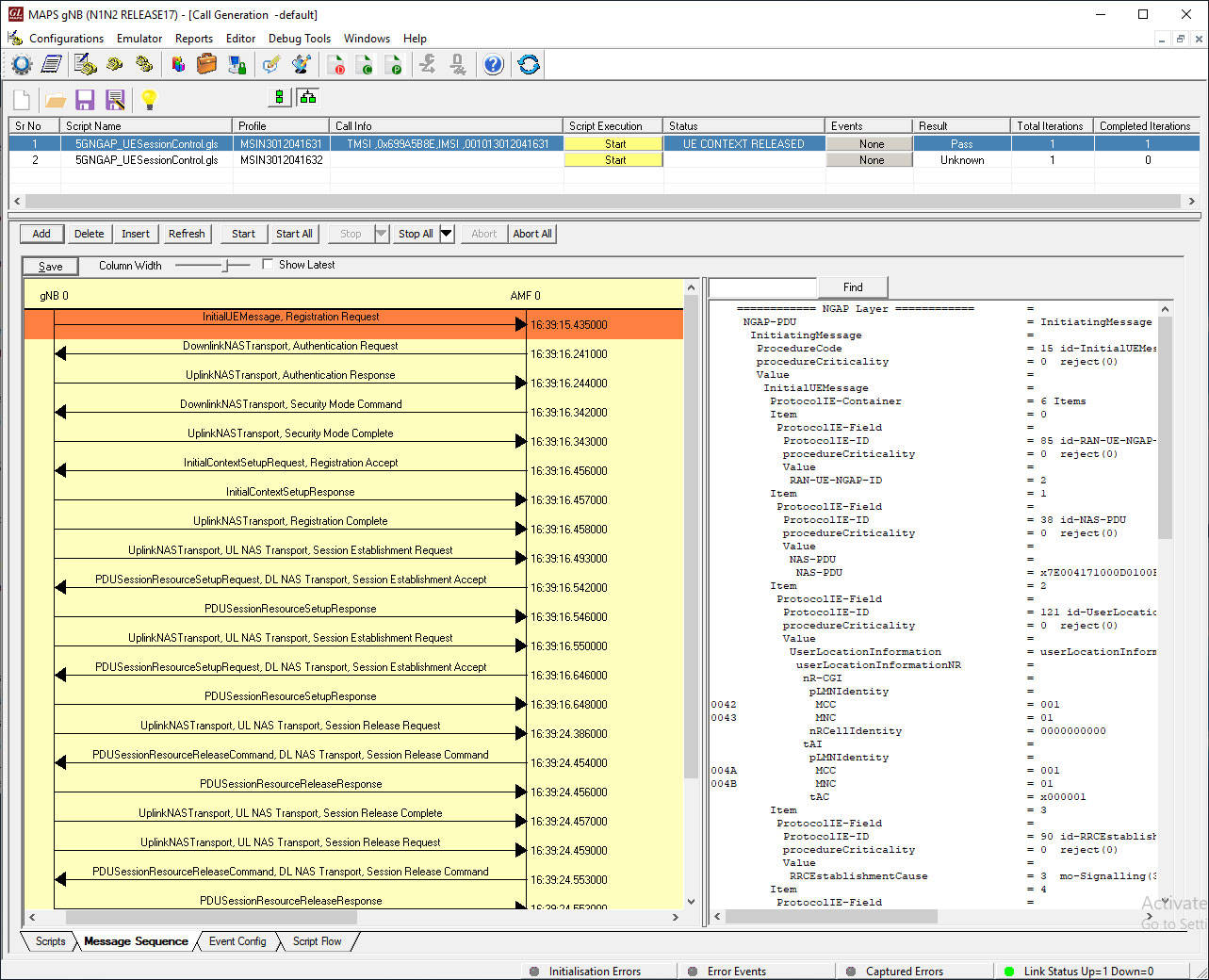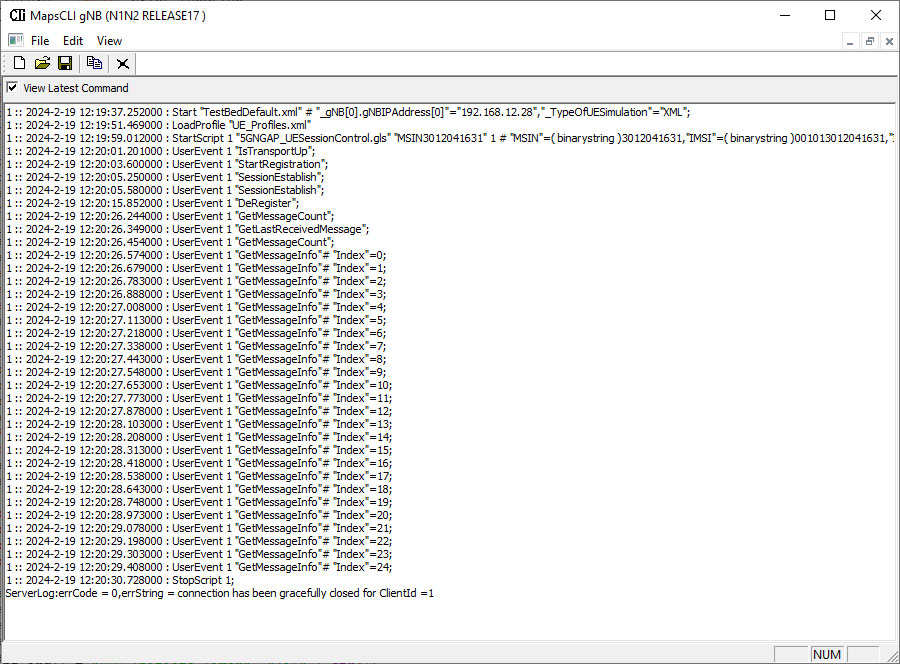5G N1 N2 Interface Emulation
N1N2 reference point emulation between the gNB (gNodeB) and the AMF (Core Access and Mobility and Management Function) supporting UE and non-UE related services.
Request a Demo / Quote BrochureOverview
GL’s Message Automation & Protocol Simulation (MAPS™) is designed for testing 5G–N1N2 interfaces , offering emulation capabilities for gNodeB (gNB) and Access and Mobility Management Function (AMF) in compliance with 3GPP standards (Release 17).
NGAP is found on the N1N2 reference point between the gNB and the AMF in order to support UE and non-UE related services. This includes operations such as configuration updates, UE context transfer, PDU Session resource management and support for mobility procedures. The user (UE) has very high-speed RF connection to the nearest local tower. This high-speed connection is always ON, as long as the mobile is powered up. 5G is designed for compatibility with older 2G, 3G and 4G (LTE) mobile systems.
The gNodeB serves as the base station within the 5G Core/NGAP interface and also includes AMF for control plane signaling, as depicted in the network diagram provided above.
The application is available as
- MAPS™ 5G-N1N2 (PKS500 licenses)
MAPS™ N1N2 Emulator supported Procedures are - NG Reset, NG Setup, Initial Context Setup, UE Context Release, Registration, De-registration, Primary authentication and key agreement procedure, Security mode control, Identification. The application gives the users an unlimited ability to edit NGAP/NAS messages and call scenarios (message sequences). "Message sequences" are generated through scripts. "Messages" are created using message templates.
Possible applications include:
- NGAP and NAS procedure and protocol compliance testing
- Simulate multiple gNBs/AMFs and thousands of subscribers using CSV configurations
- 5G System wide features such as SMS, Location Services, Emergency Services
- Authenticate and confirm security procedures
- QoS requests for greater or lesser bandwidth
- Temporary addressing management for mobility and security
GL has enhanced its MAPS™ protocol emulation tool to simulate multi-protocol and multi-interface offering a complete range of test solutions, covering the entire 5G, 4G, 3G and 2G network.
By mimicking real-world customer behavior in lab environments, our solutions allow mobile operators and equipment manufacturers to verify their 5G networks before deployment.
The product supports Mobile traffic core – GTP (ETH101) emulation for user-plane packet transmission and reception services between any two nodes in 5G network. Mobile Traffic Core – Gateway (ETH102) module allows emulation of Gateway Traffic to test media gateway telephony interfaces over IP.
GL also provides a GUI based Multi-Protocol Analyzer for on-line capture and decode of the signaling in real-time both during tests and as a stand-alone tracer for live systems.
Main Features
- Setup a virtual real-time scenario emulating 5G interoperability with 4G-LTE network elements
- Emulates UE+gB and AMF nodes.
- Supports Control plane signaling and User plane traffic
- Supported Procedures in N1 and N2 interfaces include-
- NG Reset
- NG Setup
- Initial Context Setup
- UE Context Release
- Registration
- De-registration
- Primary authentication
- Key Agreement Procedure
- Security mode control
- Identification
- Generate thousands of UE Signaling (Load Testing).
- Generate and process NGAP/NAS (valid and invalid) messages.
- Insertion of impairments to create invalid messages
- Supports customization of call flow and message templates using Script and Message Editor.
- Ready-to-use scripts for quick testing
- Supports scripted call generation and automated call reception.
- Provides Call Statistics and Events Status.
- Automation, Remote access, and Schedulers to run tests 24/7
Supported Protocols Standards
System Architecture for the 5G |
3GPP TS 23.501 (Release 17) |
NG Application Protocol (NGAP) |
3GPP TS 38.413 (Release 17) |
Non-Access-Stratum (NAS) |
3GPP TS 24.501 (Release 17) |
GPRS Tunneling Protocol for Control Plane (GTPv2-C) |
3GPP TS 29.274 (Release 17) |
NR and NG-RAN Overall Description |
3GPP TS 28.300 (Release 17) |
Packet Forwarding Control Protocol (PFCP) |
3GPP TS 29.244 (Release 17) |
- NG Application Protocol (NGAP): Application Layer Protocol between the gNB and the AMF.
- SCTP for the control plane (SCTP): This transport layer protocol guarantees delivery of signaling messages between AMF and gNB (N1N2). SCTP is defined in RFC 2960.
Use Cases
5G N1N2 Interface Procedure
In 5G N1N2 interface, MAPS™ acts as either gNB to test AMF or AMF to test gNB emulating the following call control procedure.
- MAPS™ N1N2 Emulator supported Procedures are - NG Reset, NG Setup, Initial Context Setup, UE Context Release, Registration, De-registration, Primary authentication and Key agreement procedure, Security mode control, Identification.
The below screenshots depict the Call Control Procedure simulation across 5G N1N2 interface between gNB and AMF.
CLI/API

MAPS™ can be configured as server-side application, to enable remote controlling through command-line based Python client. Python is supported over all protocols as a standard.
The MAPS™ APIs allows for programmatic and automated control over all MAPS™ platforms. Each MAPS™ server can receive multiple client connections and offer independent execution to the client. Likewise, a single client can connect to multiple MAPS™ servers, including servers running different protocols, permitting complex cross-protocol test cases.
Client provides a simple scripting language, with programming facilities such as looping, procedures, and variables. The Client application includes a packaged library that enables communication with the Server from the client environment. The advantage of such communication enables user to control MAPS™ by sending commands and receiving responses in a scripting language already familiar with many users.
The following screenshots depicts transaction of API commands between the Python Client MAPS™ CLI Server.
For more information, please visit MAPS™ APIs for Complete Automation webpage.
Resources
Note: PCs which include GL hardware/software require Intel or AMD processors for compliance.
| Presentations |
|---|
| MAPS™ 5G N1N2 Interface Emulator - Presentation |
| MAPS™ 5G Network Emulation Suite - Presentation |
| PacketScan™ 5G Protocol Analyzer Presentation |
| Webinar |
|---|

|








